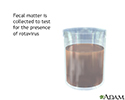Rotavirus antigen test
Gastroenteritis - rotavirus antigen
The rotavirus antigen test detects rotavirus in the feces. This is the most common cause of infectious diarrhea in children.
How the Test is Performed
There are many ways to collect stool samples.
- You can catch the stool on plastic wrap that is loosely placed over the toilet bowl and held in place by the toilet seat. Then you put the sample into a clean container.
- One type of test kit supplies a special toilet tissue to collect the sample, which is then placed in a container.
- For infants and young children wearing diapers, line the diaper with plastic wrap. Position the plastic wrap to prevent urine and stool from mixing in order to get a better sample.
The sample should be collected while the diarrhea is occurring. Take the sample to the lab to be checked.
How to Prepare for the Test
No special preparation is necessary for this test.
How the Test will Feel
The test involves normal defecation.
Why the Test is Performed
Rotavirus is the leading cause of gastroenteritis ("stomach flu") in children. This test is done to diagnose a rotavirus infection.
Normal Results
Normally, rotavirus is not found in the stool.
Note: Normal value ranges may vary slightly among different laboratories. Some labs use different measurements or test different samples. Talk to your health care provider about the meaning of your specific test results.
What Abnormal Results Mean
Rotavirus in the stool indicates a rotavirus infection is present.
Risks
There are no risks associated with this test.
Considerations
Because rotavirus is easily passed from person to person, take these steps to prevent the germ from spreading:
- Wash your hands well after contact with a child who could be infected.
- Disinfect any surface that has been in contact with stool.
Ask your provider about a vaccine to help prevent severe rotavirus infection in children under 8 months old.
Watch infants and children who have this infection closely for signs of dehydration.
References
Bass DM. Rotaviruses, calciviruses, and astroviruses. In: Kliegman RM, St. Geme JW, Blum NJ, Shah SS, Tasker RC, Wilson KM, eds. Nelson Textbook of Pediatrics. 21st ed. Philadelphia, PA: Elsevier; 2020:chap 292.
Boggild AK, Freedman DO. Infections in returning travelers. In: Bennett JE, Dolin R, Blaser MJ, eds. Mandell, Douglas, and Bennett's Principles and Practice of Infectious Diseases. 9th ed. Philadelphia, PA: Elsevier; 2020:chap 319.
Cortese MM. Rotaviruses. In: Long SS, ed. Principles and Practice of Pediatric Infectious Diseases. 6th ed. Philadelphia, PA: Elsevier; 2023:chap 216.
Franco MA, Greenberg HB. Rotaviruses, noroviruses, and other gastrointestinal viruses. In: Goldman L, Schafer AI, eds. Goldman-Cecil Medicine. 26th ed. Philadelphia, PA: Elsevier; 2020:chap 356.
Kotloff KL. Acute gastroenteritis in children. In: Kliegman RM, St. Geme JW, Blum NJ, Shah SS, Tasker RC, Wilson KM, eds. Nelson Textbook of Pediatrics. 21st ed. Philadelphia, PA: Elsevier; 2020:chap 366.
Review Date: 5/4/2022
Reviewed By: Michael M. Phillips, MD, Emeritus Professor of Medicine, The George Washington University School of Medicine, Washington, DC. Also reviewed by David C. Dugdale, MD, Medical Director, Brenda Conaway, Editorial Director, and the A.D.A.M. Editorial team.





